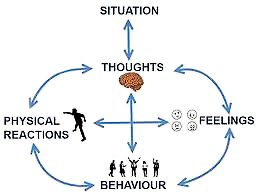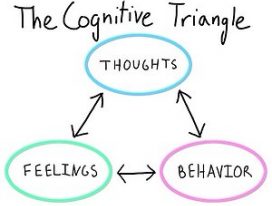Cognitive Behaviour Therapy
CBT THERAPY is based on the idea, the way you think about a situation will have a major impact on how you feel and behave.

Say you are in a social situation where you're feeling anxious and then start putting a lot of pressure on yourself and thinking ‘I want them to accept me' or 'I must get on with them', it’s likely you will be even more anxious. Then you may become quite stressed about going to social events and even stop yourself meeting people. If this carries on it may affect your eating and sleeping, and it could also lead to some psychosomatic symptoms – such as headaches or tightness in the chest when you get anxious.
GETTING ON THE 'TREADMILL'
If these issues persist it can lead you into a negative cycle. The way you’re thinking that you must get on with people for example, the stress and the physical feelings, and also behaving in a way that doesn’t deal with the situation, can lead to a sense of increasing pressure and things getting more difficult. This can sometimes feel like being trapped on a treadmill, where you're trying to get off, but finding it hard to do just that.
UNDERSTANDING YOUR NEGATIVE THOUGHTS
The aim of CBT is not so much to understand and emphasise what appears to be the obvious link between the social situation and the consequences such as feeling anxious and depressed, avoiding social situations and even not eating and sleeping properly. But more about what you bring to the situation, your thinking that sees it in a problematic or negative way, or what is sometimes called a 'catastrophising' way of viewing the world: ‘I must get them to like me’ or 'They don't like me' can become, ‘I'm not likable’ and finally, 'I’m useless’ or something similar on the same theme.
These are ways of relating to situations that probably have their origins someway back in the past and have now become well established. They may have made sense at one time as a way of coping, but now they don't work, and yet in spite of your best intentions you find yourself back in this negative way of thinking. This pushing yourself to be accepted may have worked as a child and pleased your parents, but now it can be a real burden with negative consequences. Trying to please people all the time doesn't really work, and it is very hard to be yourself when you're worrying about what other people will think of you.

MAKING CHANGES
But once you begin to see and understand this negative way of thinking, it becomes possible to question and challenge these thoughts, to put them in a context where they lose this very critical and guilty quality, and in turn make them more relative. ‘I must get on with them’ can become ‘It is true, I do want to get on and be accepted. But sometimes it doesn't work out, but that doesn’t mean I’m a failure’.
Not only do you work to change and 'relativise' the negative thoughts, you can also change some of the behaviours that are contributing to the problem. This could involve thinking about who are your friends, and what do you actually like doing. Also sometimes choosing not to go out, rather than putting pressure on yourself to be in situations you don't really want to be in. Likewise you may have got into the habit of not eating properly or exercising, and you could address this in a more creative way.
The key is that though you can’t change the outside events, or it’s much harder to change the environment around you, you can make changes about how you think and behave. In doing this, a step at a time, you move from a place in which things are linked in this negative way, to one in which you begin to see , not only do you play a part in what you are going through, but you can also do something about it. Beginning to see you can change things, helps you to think in a more positive way about yourself and the problems you are facing.

BEING YOUR OWN THERAPIST
Cognitive Behaviour Therapy emphasises the importance of defining what the problem is and working towards a solution. It is usually short-term and emphasises a collaborative approach in which the client learns how to be their own therapist - in other words how to use the techniques of CBT themselves. This can happen in the sessions, with the therapist showing the client how to understand and change their own negative thoughts. But also by carrying out graded tasks between sessions and keeping a diary so you are more aware of your negative response to problems as they arise. This in turn will help you think about how to deal with situations in a way that's more realistic and adapted to the difficulties you are facing, and actually go out there and make these changes.
ADVANTAGES & DISADVANTAGES OF COGNITIVE BEHAVIOUR THERAPY
The advantage of CBT is that it can quite rapidly, by understanding the states of mind you are getting into, challenge these negative thought patterns and behaviours and find a more creative way of dealing with the problem. The disadvantage is that the problem may have deeper roots. Then you need more time to understand what's going on and work things through, and the whole process is not so amenable to this more active approach with its emphasis on finding a solution. It is also a question of what the client wants. Different therapeutic approaches suit different clients at different times.
IN SUMMARY
- Cognitive Behaviour Therapy is based on the idea, how you think about a situation, will have a real impact on the way you feel and act.
- Seeks to make you aware of your negative thinking.
- Finds ways of challenging your negative thought patterns.
- Thinks about practical strategies you can use at work and in your relationships outside.
- Emphasises a short-term and solution focused approach.

©2022 Kevin Rose
Powered by WebHealer